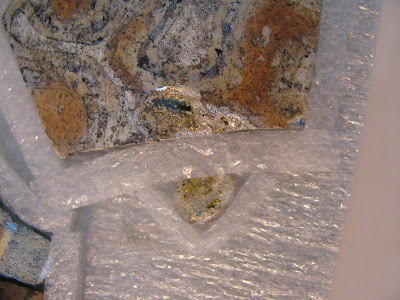One of the difficulties of identifying glass colors is finding a suitable light source for viewing the object. To facilitate our examination, we set up a temporary light-box. This was made by supporting the microscope on a glass plate, suspended over a lamp in a plastic crate. This created a way to view the piece in transmitted light while under magnification.
The surface of the fragments are heavily weathered, obscuring the original colors of the glass. In some areas, we mechanically removed small portions of the weathering layer to determine if the colors of the weathering layers correspond to the colors of the glass underneath. The appearance of the weathering layers on separate pieces did not always correspond, indicating that fragments might have been subject to different burial environments. In our investigation, we were able to determine that several of the fragments share a repeating pattern of blue, yellow, and aquamarine, suggesting that they are from the same vessel.
One fragment appears to contain gold sandwiched between layers of colorless glass, which is a known technique in ancient glass manufacture. This bowl is Roman and dates to the first half of the 1st century C.E. The gold was observed several seasons ago by a different group of conservators and Janet was interested in looking further at the other fragments to see if more areas with gold could be identified. We weren't able to identify other areas of gold foil, but this would be a promising area for materials analysis of these glass pieces.
While the construction of the majority of the pieces is similar, there are several pieces made with a short strip technique. While stored together, these mosaic pieces appear to come from an entirely separate vessel and likely date to the Hellenistic period. Stylistic features can be useful in the dating and classification of glass, and the technical study of these pieces will assist Janet in her analysis and interpretation of the Gordion glass assemblage.
Jessie examines the glass on our improvised light table
The small fragment at the bottom reveals gold foil sandwiched
between two colorless layers.
The short strip mosaic fragment
While the construction of the majority of the pieces is similar, there are several pieces made with a short strip technique. While stored together, these mosaic pieces appear to come from an entirely separate vessel and likely date to the Hellenistic period. Stylistic features can be useful in the dating and classification of glass, and the technical study of these pieces will assist Janet in her analysis and interpretation of the Gordion glass assemblage.




No comments:
Post a Comment